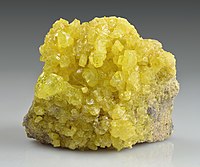
Photo from wikipedia
Abstract Perovskite oxides displaying mixed ionic and electronic conductivity have attracted a lot of interest for application in oxygen separation membranes. Such membranes could be used for a range of… Click to show full abstract
Abstract Perovskite oxides displaying mixed ionic and electronic conductivity have attracted a lot of interest for application in oxygen separation membranes. Such membranes could be used for a range of processes, including the conversion of natural gas to hydrogen or syngas. A major limitation of these materials is their tendency to segregate into simpler oxides under operating conditions, reacting with sulphur-based species often found in natural gas and leading to irreversible membrane degradation over time. Here we aim to delay or prevent this process by coating La0.6Sr0.4Co0.2Fe0.8O3-δ membranes with Alumina (Al2O3) layers of 1–100 nm thickness by using atomic layer deposition. We show that coatings of about 30 nm have negligible negative effect on O2 transport flux across the membrane and display good flux recovery when H2S is removed from the stream. Coatings thinner than this critical value provide little protection against irreversible poisoning while thicker coatings dramatically decrease overall O2 permeation fluxes. We also show that the irreversible sulphur poisoning under O2 permeation conditions is linked to microstructural and composition changes at the membrane surface caused predominantly by the formation of SrSO4 particles at the perovskite grain boundaries.
Journal Title: Journal of Membrane Science
Year Published: 2021
Link to full text (if available)
Share on Social Media: Sign Up to like & get
recommendations!